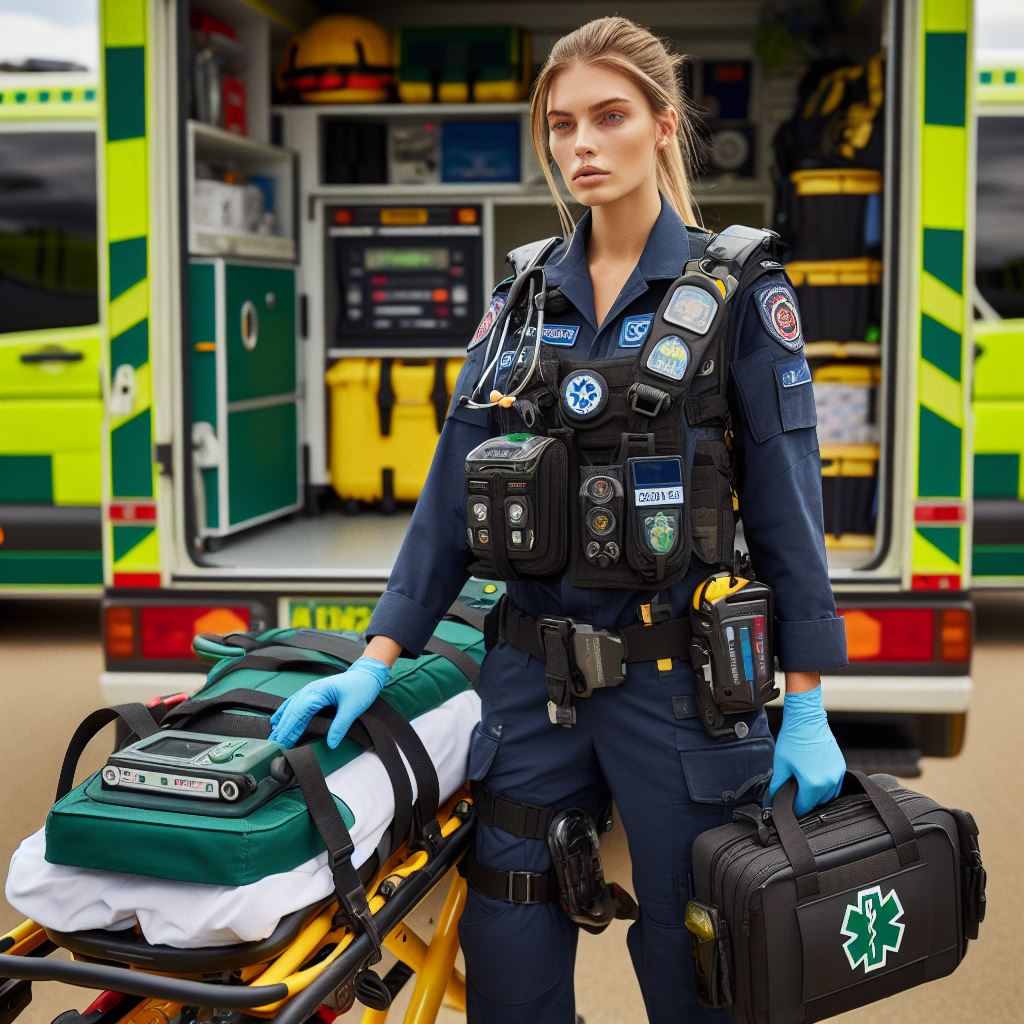Introduction
Australian paramedics in rural and urban settings have distinct roles and responsibilities.
Delving into the world of Australian paramedics, we explore the distinctions between the rural and urban roles, highlighting their crucial significance in the healthcare landscape.
Recognizing the unique challenges and diverse skill sets required, this comparison aims to shed light on the dynamic nature of paramedic responsibilities across different settings.
Understanding these variations is pivotal, not only for those considering a paramedicine career but also for fostering a comprehensive appreciation of paramedics’ indispensable roles in both rural and urban contexts.
Let’s embark on a journey to unravel the nuances and appreciate the diverse challenges faced by Australian paramedics in varying environments.
Definition and description of rural paramedics in Australia
What constitutes a rural area
Rural paramedics in Australia play a vital role in providing emergency medical care to communities located outside of major cities.
Their work encompasses a wide range of responsibilities and challenges that differ from those faced by paramedics in urban areas.
Characteristics of rural paramedic roles
To begin with, understanding what constitutes a rural area is essential. In Australia, rural regions are typically characterized by their distance from major cities or metropolitan areas.
These areas often have smaller populations and limited infrastructure compared to urban centers.
Paramedics working in rural areas face unique characteristics in their roles. Limited resources and facilities are one of the primary challenges they encounter.
Unlike urban paramedic teams who have access to well-equipped hospitals and advanced medical technology, their rural counterparts often operate with lesser resources.
This scarcity can pose significant difficulties when responding to emergencies and providing immediate medical care.
Wider scope of practice
Furthermore, the scope of practice for rural paramedics is often broader compared to their urban counterparts.
In rural areas where access to medical professionals is limited, paramedics are required to possess a broader skill set and perform a wider range of medical procedures.
They must be able to handle a variety of medical emergencies, from trauma cases to childbirth, and manage the patients until they can be transported to a hospital.
Greater isolation and longer response times
The isolation faced by rural paramedics is another significant factor that sets them apart. With greater distances between towns and healthcare facilities, response times for emergencies can be much longer.
This extended travel time can potentially result in delays in accessing critical care for patients in urgent need.
Paramedics in rural areas must navigate remote and less developed road networks, sometimes even relying on helicopters or other unconventional methods to reach patients quickly.
Despite these challenges, rural paramedics play a crucial role in maintaining the health and safety of their communities.
Their perseverance, adaptability, and commitment to their patients enable them to overcome the obstacles they face in their daily work.
In review, rural paramedic roles in Australia are characterized by limited resources and facilities, a broader scope of practice, and greater isolation with longer response times.
Understanding these distinctive features is essential in appreciating the significant contributions rural paramedics make in providing emergency medical care to communities located outside of major cities.
Their commitment to serving these areas is invaluable in ensuring the well-being of individuals living in remote and geographically challenged regions.
Read: The Future of Medicine in Australia
Definition and Description of Urban Paramedics in Australia
Urban areas
Urban paramedics play a vital role in providing emergency medical services in densely populated areas of Australia.
The nature of their work is influenced by the characteristics of urban areas and the demands of a high call volume.
Characteristics of urban paramedic roles
Abundance of resources and facilities
With abundant resources and facilities at their disposal, urban paramedics can quickly assess and treat patients with a wide range of medical conditions.
Working in close proximity to hospitals and specialized medical centers allows them to collaborate closely with other healthcare professionals, enhancing patient care.
Specialized practice areas
They have the opportunity to specialize in various practice areas, allowing for advanced skills and knowledge development.
This specialization contributes to their ability to provide high-quality, specialized care at the scene of an emergency.
Higher call volume and shorter response times
Urban paramedics must be highly adaptable, as they face a higher call volume and shorter response times compared to their rural counterparts.
The increased population density in urban areas leads to a larger number of emergency calls. Therefore, urban paramedics must be prepared to respond to a variety of incidents throughout their shift.
Your Personalized Career Strategy
Unlock your potential with tailored career consulting. Get clear, actionable steps designed for your success. Start now!
Get StartedThe ability to reach the scene of an emergency with minimal delay is crucial in an urban setting.
Quick response times enable paramedics to provide timely medical interventions, which can significantly impact patient outcomes.
They must navigate through urban traffic, coordinate with dispatchers, and make use of efficient transportation systems to ensure they arrive at the scene promptly.
Generally, urban paramedics in Australia work in highly populated areas with developed infrastructure and abundant resources.
They serve as crucial pillars of the emergency medical services system, providing specialized care and responding efficiently to a higher call volume.
The demands of urban paramedic roles require adaptability, specialized skills, and quick response times to deliver essential medical care to individuals in need.
Read: Cultural Competence in Australian Medicine
Comparison of skills and training required for rural and urban paramedics
Skills necessary for rural paramedics
Urban paramedics deal with high call volumes and emergencies that require quick thinking, efficient triage, and effective time management. They must prioritize patients and make fast-paced decisions.
While both rural and urban paramedics share many core skills, there are distinct differences in the additional training and capabilities required for each setting.
Adaptability and problem-solving skills
Rural paramedics often face unique challenges due to limited resources and remote locations. They must be able to think quickly on their feet and adapt to changing situations.
Rural paramedics, due to their limited resources and isolation, need to be highly adaptable and excel at problem-solving.
They must be resourceful in finding innovative solutions to medical emergencies in remote areas.
Ability to work independently
Rural paramedics often work in small teams or even alone, without immediate access to backup or specialized medical support. They must be self-reliant and able to make critical decisions independently.
Working independently is a crucial skill for rural paramedics, as they often operate without immediate access to backup or specialized medical support.
They must possess the confidence and ability to handle challenging situations alone.
Skills necessary for urban paramedics
Specialization in various medical fields
Urban paramedics often have the opportunity to work closely with specialized medical teams, such as cardiac or trauma units. They need to have in-depth knowledge and skills in these specific areas.
Urban paramedics benefit from specialized training in various medical fields.
They often work alongside experts in specific areas, such as cardiology or trauma, which requires them to possess advanced knowledge and expertise in these specialties.
Fast-paced decision-making and time management
Urban paramedics face a high-pressure environment with a fast-paced workflow. They must make split-second decisions and efficiently manage their time to ensure timely and effective response to emergencies.
While both rural and urban paramedics play essential roles in saving lives, their skill sets cater to the specific demands of their respective environments.
The nature of their work determines the focus of their training and the challenges they must overcome.
It is important to recognize and appreciate the unique skills and training required for paramedics in rural and urban settings.
Both serve critical roles in the healthcare system, often under demanding circumstances, and their contributions should be valued equally.
Overall, paramedics in both rural and urban areas perform a vital service, but their roles differ in terms of the necessary skills and training required.
Rural paramedics must be adaptable, resourceful, and able to work independently.
On the other hand, urban paramedics need specialized knowledge in various medical fields and the ability to make quick decisions in a fast-paced environment.
By understanding these differences, we can better appreciate the challenges faced by paramedics in both rural and urban settings, and support their efforts in providing essential care to those in need.
Read: Impact of AI on Australian Healthcare
Stand Out with a Resume That Gets Results
Your career is worth more than a generic template. Let us craft a resume and cover letter that showcase your unique strengths and help you secure that dream job.
Get Hired
Challenges faced by rural paramedics
Limited resources and access to medical facilities
Rural paramedics often face challenges due to limited resources and access to medical facilities.
Unlike their urban counterparts, rural paramedics have to work with fewer medical resources, such as medical equipment, vehicles, and staffing.
Due to the remote nature of their work, rural paramedics may have to cover large areas with limited infrastructure, making it difficult for them to access medical facilities quickly.
This can lead to delays in critical care and impact patient outcomes.
Difficulties in recruiting and retaining staff
Rural areas often struggle with attracting and retaining paramedic staff.
The lack of amenities, professional development opportunities, and social support available in rural areas make it challenging to recruit and retain qualified paramedics.
Furthermore, the workload in rural areas can be demanding and isolating, with paramedics often working long hours and being exposed to traumatic situations.
This can contribute to burnout and further exacerbate the recruitment and retention issues.
Challenges related to long-distance travel and response times
One of the significant challenges faced by rural paramedics is the distance they must travel to reach patients.
Rural areas can have large distances between medical facilities and communities, resulting in longer travel times for paramedics.
These long travel distances can have a direct impact on response times, as paramedics must reach patients quickly during emergencies.
With limited resources, rural paramedics must often rely on efficient triage and communication systems to coordinate and prioritize their response.
Moreover, rural areas may have challenging terrain, including rugged landscapes or remote access roads, which can further delay paramedic response times.
Ultimately, rural paramedics face unique challenges compared to their urban counterparts.
Innovative solutions are needed to address challenges like limited resources, difficulty in recruiting and retaining staff, and issues related to long-distance travel in rural areas for quality healthcare.
Read: Continuing Education for Doctors in Aus
See Related Content: Medical Technician Licensing in Australia
Advantages and disadvantages of urban paramedic roles
Advantages
Access to advanced medical equipment and technology
Urban paramedics have access to advanced medical equipment and technology that can greatly enhance patient care.
In densely populated cities, hospitals and medical facilities are often equipped with the latest tools and technologies, which paramedics can utilize in their daily work.
This includes advanced diagnostics, monitoring devices, and life-saving equipment, such as defibrillators and ventilators.
Opportunities for specialization in specific areas of paramedicine
Furthermore, urban paramedics have a wide variety of specialization opportunities.
Due to the diverse and complex nature of medical conditions encountered in urban settings, paramedics can specialize in areas such as trauma, pediatrics, cardiology, or respiratory care.
This allows them to develop expertise in specific fields and provide highly specialized care to patients in need.
Disadvantages
High-stress environment due to a high volume of emergency calls
Despite the advantages, urban paramedics face certain challenges that are unique to their environment.
One major disadvantage is the high-stress environment caused by the sheer volume of emergency calls they receive.
In densely populated areas, the demand for emergency medical assistance is significantly higher, resulting in constant pressure for paramedics to respond quickly and efficiently.
This can lead to increased stress levels and burnout among urban paramedics.
Limited community engagement compared to rural areas
Additionally, urban paramedics may experience limited community engagement compared to their rural counterparts.
In rural areas, paramedics become more integrated into the community and often establish stronger relationships with locals.
They may have the opportunity to provide health education programs, follow-up visits, and preventive care initiatives.
However, in urban settings, the fast-paced nature of emergency response can limit the time and resources available for community engagement activities.
Transform Your LinkedIn for Maximum Impact
Elevate your professional brand with a LinkedIn profile that attracts recruiters, showcases your expertise, and maximizes opportunities. Stand out in your industry with a profile built for success.
Boost ProfileIn summary, urban paramedic roles offer advantages such as access to advanced medical equipment and specialization opportunities.
However, they also come with disadvantages like working in a high-stress environment due to a high call volume and limited community engagement.
It is important for paramedics to weigh these factors when considering their career path and choose the setting that aligns with their professional goals and personal preferences.
See Related Content: Latest Tech in Aussie Medical Technician Field
Learn More: Surgeons and Healthcare Policies in Oz
Advantages and disadvantages of rural paramedic roles
Rural paramedic roles offer unique advantages and disadvantages that differ from their urban counterparts. Understanding these differences is crucial in determining the best fit for aspiring paramedics.
Advantages
Increased autonomy and broader practice scope
In rural areas, paramedics often have greater independence and decision-making authority due to the limited availability of medical facilities and specialists.
They must rely on their knowledge and skills to assess and treat patients in various situations, expanding their practice scope beyond what may be allowed in urban settings.
This increased autonomy can be professionally fulfilling and rewarding.
Strong sense of community and connection
Rural areas foster tight-knit communities where paramedics become an integral part of the local support network.
They build meaningful and long-lasting relationships with patients, their families, and other healthcare providers.
This sense of community and connection can provide immense job satisfaction and a deeper understanding of the individuals they serve.
Disadvantages
Longer response times and limited resources
Rural paramedics often face challenges related to longer response times due to the vast distances they must cover to reach patients.
These delays can result in compromised patient outcomes, particularly in critical emergencies.
Additionally, limited resources and medical equipment in rural areas may hinder the paramedics’ ability to provide the same level of care available in urban settings.
Isolation and limited professional development opportunities
Rural paramedics may experience feelings of isolation due to the scarcity of colleagues and the lack of immediate access to professional support or consultation.
This isolation can impact their mental well-being and may hinder the advancement of their knowledge and skills.
Limited opportunities for professional development, such as attending conferences or specialized training programs, can also impede career growth.
Rural paramedic roles provide autonomy, community connections, and fulfillment but bring challenges like longer response times, limited resources, isolation, and fewer professional development opportunities.
Aspiring paramedics should carefully consider these factors to determine the environment where they can thrive and make the greatest impact on the communities they serve.
Discover More: Impact of Policy on Public Health Work
Delve into the Subject: Aussie Paramedics: Dealing with Trauma
Conclusion
After exploring the differences between rural and urban paramedic roles in Australia, it is clear that each setting offers its own unique challenges and rewards.
In rural areas, paramedics often face the difficulties of long distances, limited resources, and the need for self-sufficiency.
On the other hand, urban paramedics deal with high call volumes, complex trauma cases, and the pressure of working in a bustling city environment.
Despite these contrasting circumstances, aspiring paramedics should carefully consider both options.
Rural roles can provide a sense of community, diverse experiences, and the opportunity to make a significant impact in under-resourced areas.
Urban roles offer exposure to a wide range of medical conditions, advanced technologies, and the chance to work alongside specialized teams.
Moreover, it is essential to recognize the vital role of paramedics in ensuring healthcare access across Australia’s diverse regions.
They are the first line of emergency response and provide crucial pre-hospital care to both rural inhabitants and city dwellers.
Without their expertise and dedication, many individuals would not receive timely and potentially life-saving medical assistance.
In closing, aspiring paramedics should explore both rural and urban roles, appreciating their respective benefits and challenges.
By understanding the unique aspects of each setting, paramedics can make informed career choices and contribute to providing equitable healthcare access throughout Australia.




